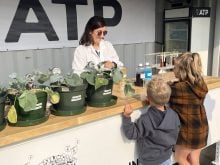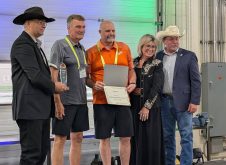Panelists warn that if Canada doesn’t find ways to make itself attractive to agri-food businesses, other countries will
Glacier FarmMedia – Agriculture and the agri-food sector can be a powerful tool for Canada both economically and geopolitcally.
That’s according to Jack Mintz, economist and president’s fellow at the University of Calgary’s Public Policy Institute.
Agriculture is a high-productivity sector with great strategic opportunities on the world stage, he told attendees of the Protein Industries Canada convention in Saskatoon last month.
Read Also

New coal mine proposal met with old concerns
A smaller version of the previously rejected Grassy Mountain coal mine project in Crowsnest Pass is back on the table, and the Livingstone Landowners Group continues to voice concerns about the environmental risks.
For that to happen though, Canadian governments and organizations at all levels need to establish a balance of research and development, innovation and infrastructure.
“When you look at the opportunities that are in agriculture, like bioenergy, genetic science, resilient crops, grain storage, there’s a whole number of new value-added opportunities,” he said.
Agriculture is one of Canada’s top five industries in terms of growth per capita, conference attendees heard. Productivity is ever increasing in the sector, not just in the provision of raw resources, but also an expansion of processed and manufactured goods from the agri-food sector.
“How many sectors of our economy can deliver $65 billion of annual economic output growth, not just back to price, but tied to output and that as well?” said Murad Al-Katib, president and chief executive officer of AGT Foods, who also spoke at the convention.
For all the optimism about agriculture and agri-food’s productivity, however, the road is getting bumpier.
The marketplace is always in flux. Players shift, new companies fight for space and everyone scrambles to deal with a shifting policy landscape. There are also issues around infrastructure and research capacity, attendees heard.
Canada and its agriculture sector don’t need new and flashy solutions to those problems, according to Tyler McCann of the Canadian Agri-Food Policy Institute. Instead, he said, there needs to be improvements to fundamental issues such as transport and infrastructure, tax systems and the regulatory environment.
Heidi Dutton, chief executive officer of Sunnydale Foods and Lovingly Made, cited her own experience, particularly when it comes to expansion efforts
“The cost to build in Canada is very, very high, and (when) we’ve priced out plants, it was very, very tight between the U.S. and Canada, particularly Saskatchewan,” said Dutton. “And I’m (from) Saskatchewan, so I’m constantly waving that flag, and in Alberta now too.”
Regulation has been a whole other obstacle.
Both Al-Katib and Dutton said that it’s much easier to establish plants in emerging markets because of lower costs, but even certain U.S. states are better than trying to set up shop in Canada. Those areas have well established infrastructure systems for building and transport, which make it easier and quicker to move product. It isn’t much cheaper to build south of the border, but U.S. state policies are competitive, even among each other, which allow and promote businesses and manufacturing to shop for locations, the speakers said.
“We can’t blame it on North America because we can go to the U.S. and find states where we can effectively build there,” said Al-Katib. “So, governments here (in Canada) haven’t recognized our regulatory burden is bad. It’s not killing us, but it’s bad. The incentive programs are nonexistent and the cost structures are inhibitive.
“So, if this is a race, we have to be recognizing that this opportunity won’t just wait around for us. If we don’t take it someone else will, and we’re seeing other countries trying to do it.”
Speakers argued that policy changes are needed if Canada wants to increase market share in the agri-food and plant-based food space.
“In Canada, there is a business community, a community of entrepreneurs that have a sense as to where they want to go and how they want to get there,” said McCann. “But again, we have a disconnected policy environment that doesn’t do a very good job facilitating and enabling the work that they want to do and creating the conditions for those entrepreneurs to be as competitive as they need to be to succeed with those destinations that they want to get to.”
That disconnect bleeds into the innovation environment as well; the two are connected, Mintz said.
Government must prioritize investment to welcome industry growth, he argued.
Speakers also said agriculture needs to be more vocal about what they need to grow.
“The reality is (the) squeaky wheel gets the grease,” said McCann. “I think we need to do a better job of understanding what are we missing in this country. How do we talk about it in a different, more strategic context, and in a way that isn’t just about ‘agriculture is a great asset,’ but ‘agriculture can help the country?’”


















